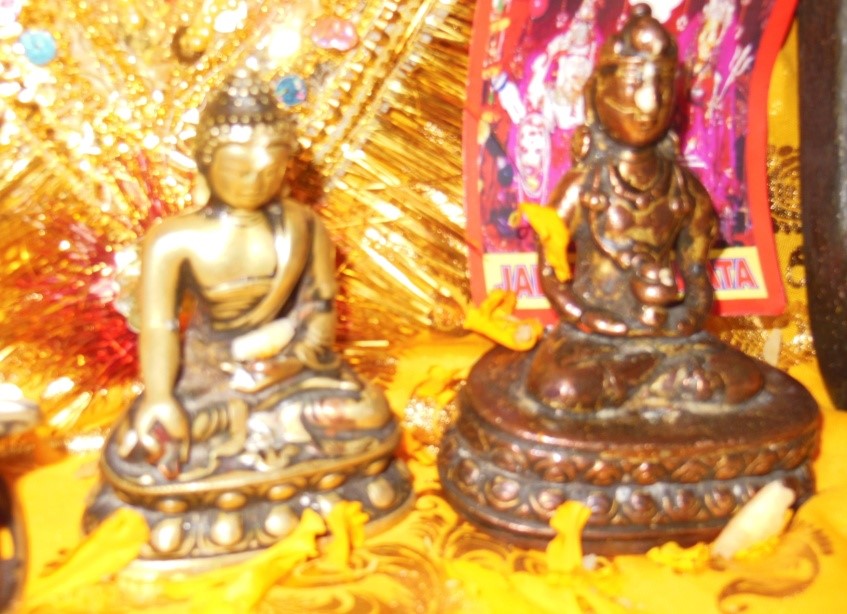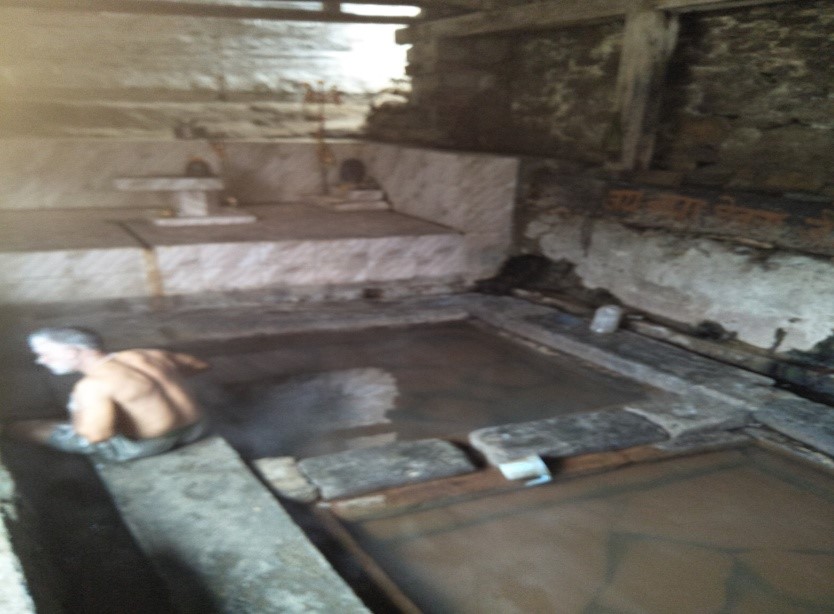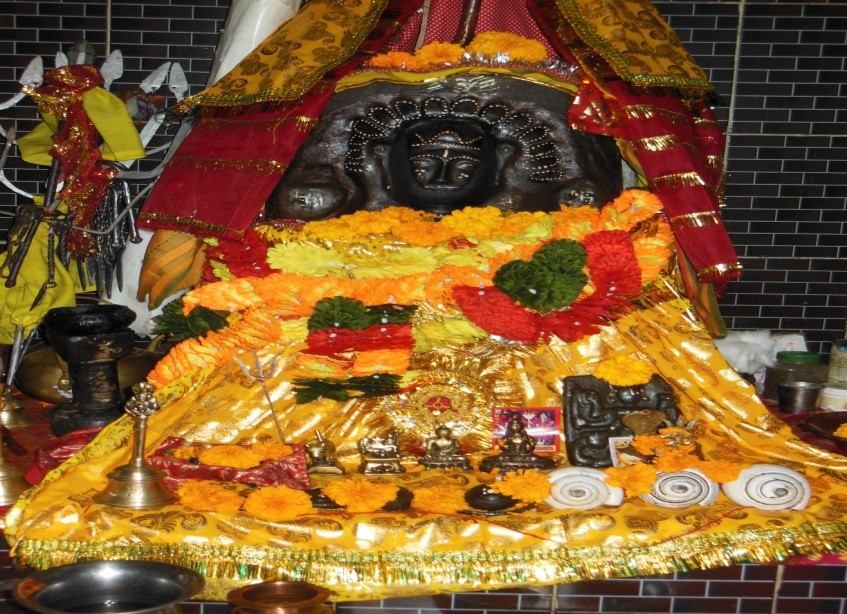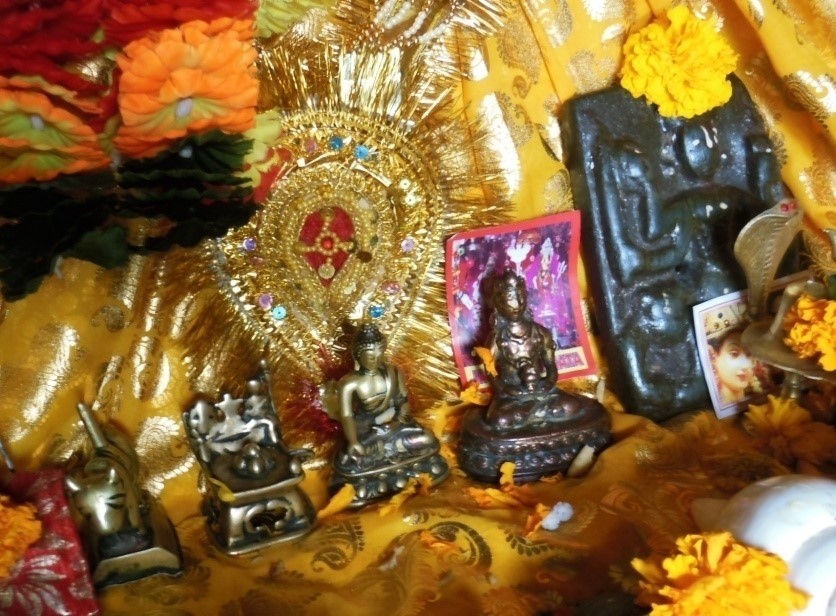THE COPPER STATUE OF MEDICINE BUDDHA / AMITĀBHA
The second sculpture, a 4.5” copper statue identified as Amitābha (Medicine Buddha), holds a bowl in both hands. This attribution requires elucidation. Amitābha (“Infinite Light”) is usually shown seated in meditation, often associated with the Pure Land (Sukhāvatī). Bhaiṣajyaguru (Medicine Buddha), however, holds a bowl of healing nectar or herbs and is deeply venerated in Tibetan Buddhism as a deity of healing and longevity (Gyatso, 1998). Given the bowl attribute, it is more accurate to identify this figure as Medicine Buddha, though the conflation with Amitābha may reflect local variations in naming. The bowl represents the healing power of Dharma, curing both physical ailments and spiritual afflictions. Medicine Buddha rituals are common in Tibetan Buddhism, often conducted for community health, protection, and spiritual well-being (Mrozik, 2007). The small size of the statue suggests personal devotion, perhaps part of a household shrine, later absorbed into the Hindu temple. Its presence highlights continuing Buddhist devotional practices even within predominantly Hindu cultural landscapes.

THE VAJRA-BELL AND SEVEN CONCH SHELLS
The Vajra (Dorje)
The vajra, or dorje in Tibetan, symbolizes indestructibility (diamond) and irresistible power (thunderbolt). In Vajrayāna ritual, it represents the method or skillful means (upāya) necessary for enlightenment (Thurman, 1991).
The Bell (Ghaṇṭa / Drilbu)
The bell symbolizes wisdom (prajñā) and the emptiness of all phenomena. Together,
vajra and bell embody the inseparability of wisdom and compassion, the core of tantric Buddhism (Beer, 2003).
The Seven Conch Shells
The conch shell (śaṅkha) is one of Buddhism’s Eight Auspicious Symbols (aṣṭamaṅgala), representing the sound of Dharma spreading across the world (Lopez, 2001). The number seven has multiple resonances in Buddhism: the seven factors of enlightenment, the seven steps taken by the infant Buddha, and the seven offerings in Vajrayāna rituals. The offering of seven conch shells and a vajra-bell in a Hindu temple setting strongly indicates that Tibetan Buddhist ritual practices once flourished in the area. Their survival in a syncretic environment suggests cultural layering, where ritual objects are preserved but their meanings evolve.
SYNCRETISM: BUDDHISM WITHIN A HINDU TEMPLE
The most striking feature of this discovery is that Buddhist artefacts and ritual objects were found in a Hindu temple of Tattapani village of Paddar area. This reveals a pattern of syncretism and shared religious space, characteristic of Himalayan regions. In many parts of Kashmir, Himachal Pradesh, and Ladakh, deities and artefacts moved between Buddhist and Hindu contexts (Kapstein, 2000). Local communities often perceived no rigid boundary between traditions; instead, they integrated Buddhist figures into Hindu cosmology or retained them as protective deities. The unidentified deity to whom the vajra-bell and conches were offered may represent a local Hindu or folk deity, with Buddhist ritual implements reinterpreted within Hindu practice. This syncretism highlights the fluid religious identity of Himalayan communities, shaped by geography, trade, and cultural interaction.
Cultural and Historical Implications
The artifacts from Tattapani village of Paddar valley of Kishtwar district provide insights into the diffusion of Tibetan Vajrayāna Buddhism into peripheral Himalayan valleys beyond its strongholds in Ladakh and Zanskar. Material culture as markers of identity, bronze and copper statuary, vajra-bell, and conches were not merely ritual objects but also signifiers of religious belonging. It also shows continuity and adaptation, even after Buddhism’s decline in Kashmir, its symbols persisted in popular


 ©
© 


